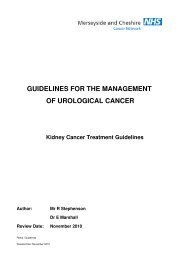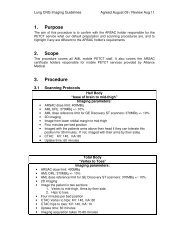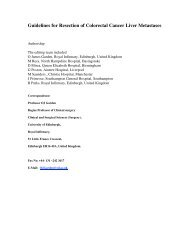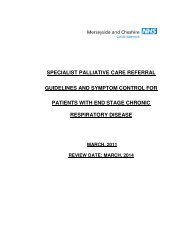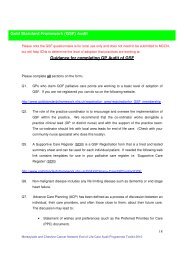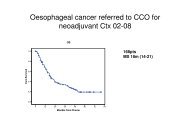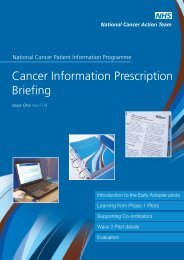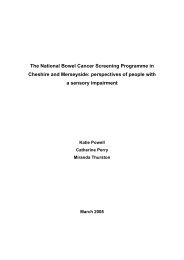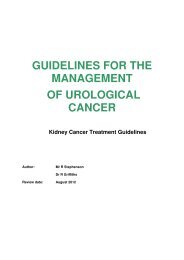Cancer Reform Strategy - NHS Cancer Screening Programmes
Cancer Reform Strategy - NHS Cancer Screening Programmes
Cancer Reform Strategy - NHS Cancer Screening Programmes
- No tags were found...
You also want an ePaper? Increase the reach of your titles
YUMPU automatically turns print PDFs into web optimized ePapers that Google loves.
CHAPTER 3: DIAGNOSING CANCER EARLIER 45The main advantages of this new technique area quicker throughput in laboratories and a largereduction in the number of samples that cannotbe read. When fully implemented acrossEngland, this should mean that 300,000 womena year will not have to be re-tested due tounreadable samples, with all the anxiety thatentails. This will also reduce the workload inlaboratories.3.8 Implementation of a NICE appraisalnormally has to be funded by Primary CareTrusts (PCTs) within three months. At the time ofthe NICE appraisal of LBC, it was recognisedthat a major programme would be needed toretrain sample takers and laboratory staff whoanalyse the samples. A waiver was thereforeissued by the Department of Health, recognisingthat full implementation within three monthswas not possible. By November 2007, 88% oflaboratories in England had converted to LBC.The benefits of LBC are already becomingapparent. Of the four million tests taken eachyear, the number of inadequate tests fell from370,000 (9%) in 2004/05 to 173,000 (4.7%)in 2006/07. This means that around 200,000women did not have to attend for a repeat test,with all the anxiety that involves. All PCTs haveindicated that they will have introduced LBC byOctober 2008 in line with NICE/DH guidance.3.9 We now wish to see four furtherimprovements in the cervical screeningprogramme:●●Reducing the variation of coveragebetween PCTs;Minimising the time taken to get resultsback to women, aiming to informwomen of the result of their cervicalscreening test within two weeks of itbeing taken;●Action to tackle the falling participationof younger women aged 25 to 35.3.10 Nationally, 79.2% of eligible women werescreened at least once in the last five years.But participation in cervical screening variesgreatly across the country, from 86.5 % inNottinghamshire County PCT to 67.4% inHammersmith and Fulham PCT. Generally,participation is lower in spearhead PCTs thanelsewhere, but there are examples of spearheadPCTs with high participation rates, such asDoncaster at 82%. Participation can beimproved by engaging with potential users at acommunity level. To incentivise services toencourage higher coverage we will exploremoving to an activity based system forfunding screening services. <strong>NHS</strong> <strong>Cancer</strong><strong>Screening</strong> <strong>Programmes</strong> will also encouragethe sharing of best practice in improvingaccessibility of screening for all groups.3.11 In September 2007, the governmentannounced its intention to speed up the resultsof cervical screening, as set out in the manifestofor the 2005 general election. Women canexpect to receive the results for their cervicalscreening test within 14 days of it being taken.The implementation of Liquid Based Cytologywill go a long way to achieving this and we havealready seen the number of women waitingmore than six weeks for their results fall from44% in 2005/06 to 27% in 2006/07. But weneed to do more and further opportunities forimprovements have been identified by formaloptions appraisals:●●●Better use of Information Technology;More Advanced Biomedical ScientistPractitioners in Cervical Cytology;Posting results letters by first class mail;●Using new technologies, such as theautomation of cytology reporting andthe use of Human Papilloma Virus (HPV)testing as and when the researchevidence supports this; and●●Reconfiguring laboratories to make themlarger and more efficient; andLarger call/recall offices would also reduceturnaround times and allow better facilitiesto improve coverage such as telephone helplines.




